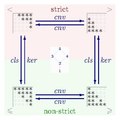PartialOrders_redundencies.pdf (383 × 383 pixels, file size: 52 KB, MIME type: application/pdf)
| This is a file from the Wikimedia Commons. Information from its description page there is shown below. Commons is a freely licensed media file repository. You can help. |
Summary
| DescriptionPartialOrders redundencies.pdf |
Connection between strict and non-strict partial orders established by converse (cnv), reflexive closure (cls), and irreflexive kernel (ker). The mappings cls and ker (on the domain of irreflexive and reflexive relations, respectively) are inverse to each other, and cnv is inverse to itself, and commutes with cls and with ker. Therefore, we have a commutative diagram. For illustration, we use four example relations on the set {1,2,3,4,5}. Each relation table shows a "*" whenever (x,y)∈R holds, where x and y corresponds to the row and column, respectively, like this: Moreover, if cpl denotes the complement of a relation, then, for every non-strict partial order R, one has
Proof of (2): "If": Let R be connected, let (x,y) ∈ cpl(R), then (x,y) ∉ R, hence (y,x) ∈ R, which also implies that x≠y, hence (y,x) ∈ ker(R), hence (x,y) ∈ cnv(ker(R)). "Only if": Assume for contradiction equality for a non-connected partial order R. Let (x,y), (y,x) ∉ R, then (x,y) ∈ cpl(R), hence (x,y) ∈ cnv(ker(R)), hence (y,x) ∈ ker(R), hence (y,x) ∈ R, contradicting the assumption. |
| Date | |
| Source | Own work |
| Author | Jochen Burghardt |
| Other versions | File:PartialOrders redundencies.pdf * File:PartialOrders redundencies svg.svg |
LaTeX source code
|
|---|
\documentclass[12pt]{article}
\usepackage[pdftex]{color}
\usepackage{amssymb}
\usepackage[paperwidth=65mm,paperheight=65mm]{geometry}
\setlength{\topmargin}{-36mm}
\setlength{\textwidth}{65mm}
\setlength{\textheight}{65mm}
\setlength{\evensidemargin}{0cm}
\setlength{\oddsidemargin}{-23mm}
\setlength{\parindent}{0cm}
\setlength{\parskip}{1ex}
\setlength{\unitlength}{1mm}
\sloppy
\begin{document}
\renewcommand{\leq}{\leqslant}
\renewcommand{\geq}{\geqslant}
% foreground
\definecolor{fOp} {rgb}{0.00,0.00,0.50} % operation
\definecolor{fNm} {rgb}{0.50,0.50,0.50} % canonical name
\definecolor{fTb} {rgb}{0.50,0.50,0.50} % relation table
\definecolor{fY} {rgb}{0.00,0.00,0.00} % related
\definecolor{fN} {rgb}{0.90,0.90,0.90} % unrelated
\definecolor{fStr} {rgb}{0.50,0.00,0.00} % strict
\definecolor{fNSt} {rgb}{0.00,0.50,0.00} % non-strict
\definecolor{fNd} {rgb}{0.00,0.00,0.75} % Hasse node
\definecolor{fAr} {rgb}{0.80,0.80,0.99} % Hasse arc
% background
\definecolor{bStr} {rgb}{0.99,0.94,0.94} % strict
\definecolor{bNSt} {rgb}{0.94,0.99,0.94} % non-strict
\definecolor{bHs} {rgb}{0.99,0.99,0.99} % Hasse diagram
\renewcommand{\arraystretch}{0.10}
\newcommand{\0}{\textcolor{fN}{*}}
\newcommand{\1}{\textcolor{fY}{*}}
\newcommand{\p}{\0}
\newcommand{\GE}{% x >= y
\begin{array}{@{}|@{}c@{}c@{}c@{}c@{}c@{}@{}}%
\hline%
\1 & \0 & \0 & \0& \0 \\% 1 <-- x
\1 & \1 & \0 & \0& \0 \\% 2
\1 & \1 & \1 & \0& \0 \\% 3
\1 & \1 & \p & \1& \0 \\% 4
\1 & \1 & \1 & \1& \1 \\% 5
% y --> 1 2 3 4 5
%\hline%
\end{array}%
}
\newcommand{\GT}{% x > y
\begin{array}{@{}|@{}c@{}c@{}c@{}c@{}c@{}@{}}%
\hline%
\0 & \0 & \0 & \0& \0 \\% 1 <-- x
\1 & \0 & \0 & \0& \0 \\% 2
\1 & \1 & \0 & \0& \0 \\% 3
\1 & \1 & \p & \0& \0 \\% 4
\1 & \1 & \1 & \1& \0 \\% 5
% y --> 1 2 3 4 5
%\hline%
\end{array}%
}
\newcommand{\LE}{% x <= y
\begin{array}{@{}|@{}c@{}c@{}c@{}c@{}c@{}@{}}%
\hline%
\1 & \1 & \1 & \1& \1 \\% 1 <-- x
\0 & \1 & \1 & \1& \1 \\% 2
\0 & \0 & \1 & \p& \1 \\% 3
\0 & \0 & \0 & \1& \1 \\% 4
\0 & \0 & \0 & \0& \1 \\% 5
% y --> 1 2 3 4 5
%\hline%
\end{array}%
}
\newcommand{\LT}{% x < y
\begin{array}{@{}|@{}c@{}c@{}c@{}c@{}c@{}@{}}%
\hline%
\0 & \1 & \1 & \1& \1 \\% 1 <-- x
\0 & \0 & \1 & \1& \1 \\% 2
\0 & \0 & \0 & \p& \1 \\% 3
\0 & \0 & \0 & \0& \1 \\% 4
\0 & \0 & \0 & \0& \0 \\% 5
% y --> 1 2 3 4 5
%\hline%
\end{array}%
}
\begin{picture}(60,60)
\thicklines
\textcolor{bStr}{\put(30,30){\makebox(0,0)[b]{\rule{60mm}{30mm}}}}%
\textcolor{bNSt}{\put(30,30){\makebox(0,0)[t]{\rule{60mm}{30mm}}}}%
\textcolor{fStr}{\put(30,59){\makebox(0,0)[t]{strict}}}%
\textcolor{fNSt}{\put(30, 1){\makebox(0,0)[b]{non-strict}}}%
\textcolor{fTb}{\put(10,10){\makebox(0,0){$\LE$}}}%
\textcolor{fTb}{\put(10,50){\makebox(0,0){$\LT$}}}%
\textcolor{fTb}{\put(50,10){\makebox(0,0){$\GE$}}}%
\textcolor{fTb}{\put(50,50){\makebox(0,0){$\GT$}}}%
\textcolor{fNm}{\put( 3, 4){\makebox(0,0)[t]{$\leq$}}}%
\textcolor{fNm}{\put( 3,56){\makebox(0,0)[b]{$<$}}}%
\textcolor{fNm}{\put(57, 4){\makebox(0,0)[t]{$\geq$}}}%
\textcolor{fNm}{\put(57,56){\makebox(0,0)[b]{$>$}}}%
\textcolor{fOp}{\put(17,11){\vector(1,0){26}}}%
\textcolor{fOp}{\put(30,12){\makebox(0,0)[b]{$\it cnv$}}}%
\textcolor{fOp}{\put(43,9){\vector(-1,0){26}}}%
\textcolor{fOp}{\put(30,8){\makebox(0,0)[t]{$\it cnv$}}}%
\textcolor{fOp}{\put(17,51){\vector(1,0){26}}}%
\textcolor{fOp}{\put(30,52){\makebox(0,0)[b]{$\it cnv$}}}%
\textcolor{fOp}{\put(43,49){\vector(-1,0){26}}}%
\textcolor{fOp}{\put(30,48){\makebox(0,0)[t]{$\it cnv$}}}%
\textcolor{fOp}{\put(11,17){\vector(0,1){26}}}%
\textcolor{fOp}{\put(12,30){\makebox(0,0)[l]{$\it ker$}}}%
\textcolor{fOp}{\put( 9,43){\vector(0,-1){26}}}%
\textcolor{fOp}{\put( 8,30){\makebox(0,0)[r]{$\it cls$}}}%
\textcolor{fOp}{\put(51,17){\vector(0,1){26}}}%
\textcolor{fOp}{\put(52,30){\makebox(0,0)[l]{$\it ker$}}}%
\textcolor{fOp}{\put(49,43){\vector(0,-1){26}}}%
\textcolor{fOp}{\put(48,30){\makebox(0,0)[r]{$\it cls$}}}%
%
\textcolor{bHs}{\put(25,23){\makebox(0,0)[bl]{\rule{10mm}{14mm}}}}%
\thinlines
\textcolor{fAr}{\put(30,24){\line(0,1){4}}}%
\textcolor{fAr}{\put(30,28){\line(-1,1){4}}}%
\textcolor{fAr}{\put(30,28){\line(1,1){4}}}%
\textcolor{fAr}{\put(26,32){\line(1,1){4}}}%
\textcolor{fAr}{\put(34,32){\line(-1,1){4}}}%
\textcolor{bHs}{\put(30,24){\makebox(0,0){\rule{2mm}{2mm}}}}%
\textcolor{bHs}{\put(30,28){\makebox(0,0){\rule{2mm}{2mm}}}}%
\textcolor{bHs}{\put(26,32){\makebox(0,0){\rule{2mm}{2mm}}}}%
\textcolor{bHs}{\put(34,32){\makebox(0,0){\rule{2mm}{2mm}}}}%
\textcolor{bHs}{\put(30,36){\makebox(0,0){\rule{2mm}{2mm}}}}%
\textcolor{fNd}{\put(30,24){\makebox(0,0){$\scriptscriptstyle 1$}}}%
\textcolor{fNd}{\put(30,28){\makebox(0,0){$\scriptscriptstyle 2$}}}%
\textcolor{fNd}{\put(26,32){\makebox(0,0){$\scriptscriptstyle 3$}}}%
\textcolor{fNd}{\put(34,32){\makebox(0,0){$\scriptscriptstyle 4$}}}%
\textcolor{fNd}{\put(30,36){\makebox(0,0){$\scriptscriptstyle 5$}}}%
\end{picture}
\end{document}
|
Licensing
- You are free:
- to share – to copy, distribute and transmit the work
- to remix – to adapt the work
- Under the following conditions:
- attribution – You must give appropriate credit, provide a link to the license, and indicate if changes were made. You may do so in any reasonable manner, but not in any way that suggests the licensor endorses you or your use.
- share alike – If you remix, transform, or build upon the material, you must distribute your contributions under the same or compatible license as the original.
Captions
Items portrayed in this file
depicts
some value
29 July 2021
application/pdf
File history
Click on a date/time to view the file as it appeared at that time.
| Date/Time | Thumbnail | Dimensions | User | Comment | |
|---|---|---|---|---|---|
| current | 09:54, 1 January 2022 |  | 383 × 383 (52 KB) | Jochen Burghardt | mirror row/col in image |
| 15:25, 31 July 2021 |  | 383 × 383 (52 KB) | Jochen Burghardt | used *partial* order example, added hasse diagram, colorized strict/nonstrict | |
| 19:18, 29 July 2021 |  | 383 × 383 (41 KB) | Jochen Burghardt | Uploaded own work with UploadWizard |
File usage
Metadata
This file contains additional information, probably added from the digital camera or scanner used to create or digitize it.
If the file has been modified from its original state, some details may not fully reflect the modified file.
| Software used | TeX |
|---|---|
| Conversion program | pdfTeX-1.40.20 |
| Encrypted | no |
| Page size | 184.252 x 184.252 pts |
| Version of PDF format | 1.5 |


